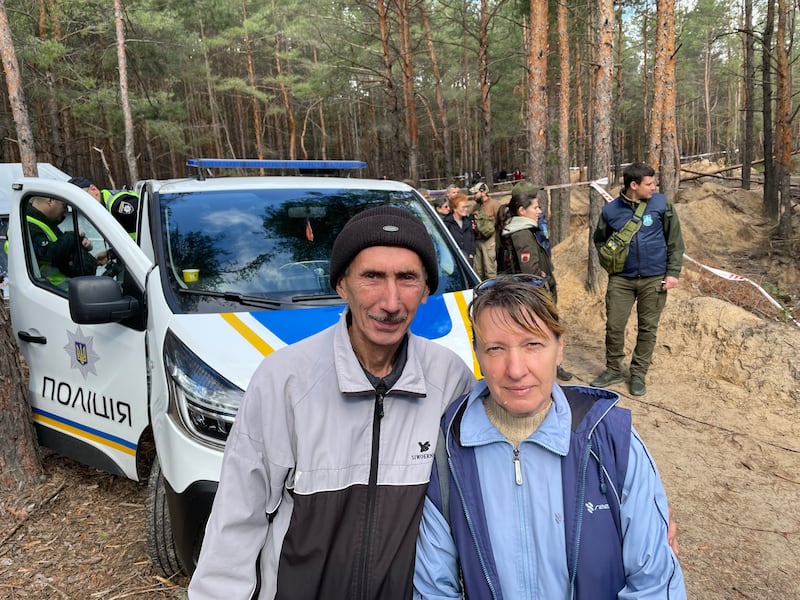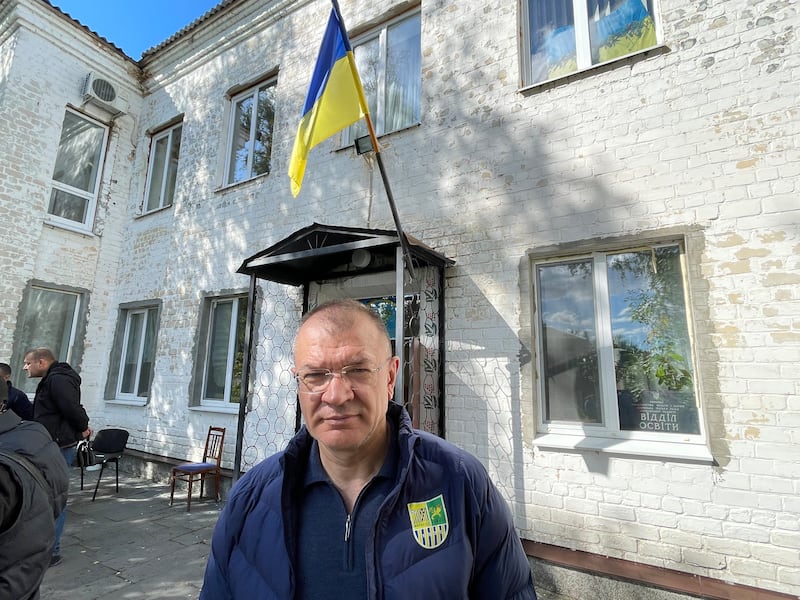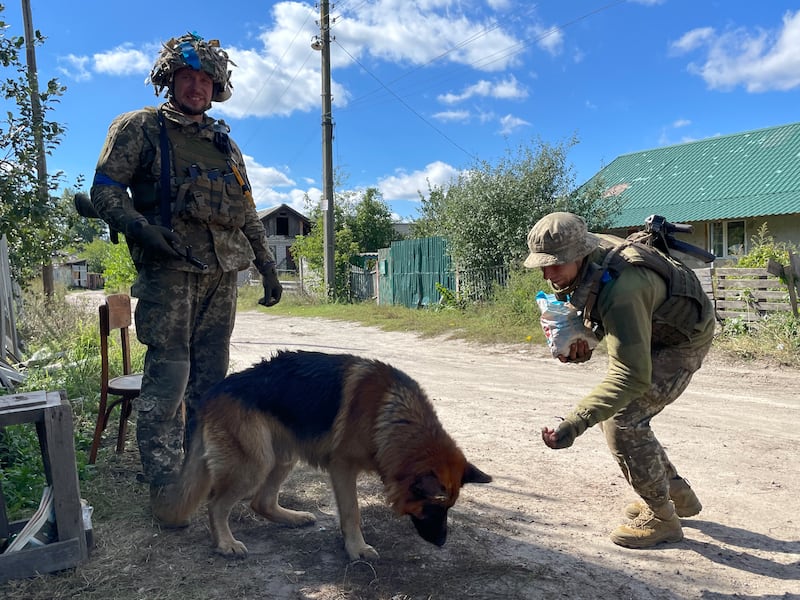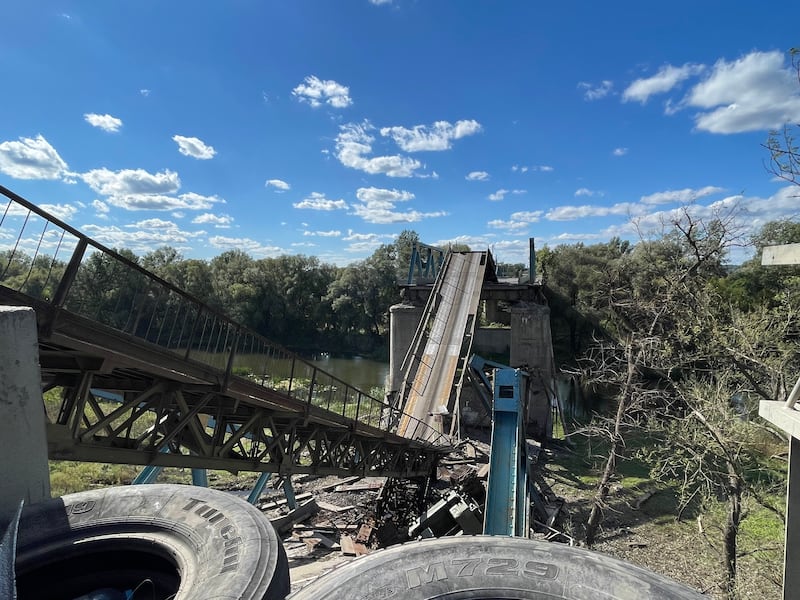After driving the Kremlin’s invasion force from its northeastern Kharviv region, Ukraine is now racing to repair towns and villages shattered by six months of war and occupation as a new enemy — winter — threatens their people with more misery and danger.
The road from Kharkiv city to Izyum, 130km to the southeast, now brings demining teams, repair crews and aid workers past checkpoints and signs of recent battle to a liberated but ruined town, where most people live without power, heat, water and phone services.
Local officials and some residents who fled Izyum are now returning, and police officers, prosecutors and forensic teams arrive each day from Kharkiv to investigate a mass grave and reports of torture and other crimes allegedly committed by Russian troops.
In a pine forest where the sandy soil is thought to hide more than 450 bodies, people gather to seek news of where relatives are buried and do not react to the repeated crack of explosions as sappers make safe landmines and shells that are strewn around Izyum.
READ MORE
[ Izyum graves: ‘When they buried my mother they didn’t even give me the number’Opens in new window ]
“There was constant shelling and there’s no basement in our building, so we spent our time in the corridor, praying that we wouldn’t be hit,” says Natalia Zhernova, who is trying to find out where her mother-in-law was buried in the forest after she died of natural causes during the occupation
“Our flat took a direct hit from a cluster bomb and a wall and the windows were smashed, so we moved to my mother’s flat, where five of us lived together,” she explains.
“Winter will be very hard. If there’s still no gas supply in our flat then we’ll stay in the cottage where my mother-in-law lived. It has a stove and we’re already gathering wood for it. Some windows are broken there too, but we’ll board them up and do what we can.”

Russia relinquished Izyum with little fight this month, abandoning the important transport hub on the Siverskyi Donets in the face a major counterattack by Ukrainian troops, and leaving behind many tanks and other armoured vehicles and big stores of ammunition.
By then, however, the damage was done: the city witnessed intense battles in March, shortly after Russia’s full-scale invasion of Ukraine, and suffered heavy shelling during an occupation that prompted about two-thirds of its 45,000 population to flee.
Buildings on almost every street are now scarred, whether blackened by blast marks and fire, punctured and cracked by a shell, or showing windows shattered and walls strafed by gunfire and flying shrapnel.
People now walk around and sit on benches without fear of bombardment or a potentially dangerous encounter with Russian troops. But as autumn leaves and horse chestnuts fall among the bullet casings and shrapnel that tinkle underfoot in its streets and yards, Izyum’s relief mingles with fear about what winter will bring to this wounded region.

“We estimate that more than 80 per cent of apartment buildings have been damaged and some 2,000 houses, as well as lots of infrastructure including heating stations,” says Stepan Maselskyi, head of the Izyum district’s military-civilian administration.
“Our main priorities are to repair critical infrastructure such as electricity, gas, water supplies and the mobile phone network, as well health services and all the other basic, civilised services that people need, such as stable food and medical supplies,” he explains.
“We are undoubtedly in a tough situation,” he admits, outside an administration building where Ukraine’s blue-and-yellow banner flies again above the door and a muddied Russian flag now serves as a doormat.
“With winter coming we need to solve these problems as quickly as possible. But specialists tell us that it’s just physically impossible to fix every building before the cold season, no matter how much we want to do it,” Maselskyi says.
“So as a priority we will repair what we can of the most essential things, like the less badly damaged residential buildings and heating stations.”
[ The foreign volunteers training Ukraine’s new recruitsOpens in new window ]
About 15,000 people are now thought to be living in Izyum and there is already a slow trickle of returnees. But officials urge people to be patient about coming home.
“It’s better to wait. Now sappers are working to demine buildings, because the occupiers left behind many dangerous things — mines and tripwires and so on — and unfortunately civilians have been wounded by them. So people should wait until the city is safe and we have at least restored electricity and water supplies,” says Maselskyi.
Other damage to Izyum and the region is less visible, and harder to gauge and to repair: the impact on locals of months of isolation and fear, of lack of food and the death of loved ones both from violence and from shortages of essential medicines.
“No one can say now how many civilians died here during the occupation. Work is taking place to establish that, including exhumations. But I think more than 1,000 people died — although of course I hope that I’m wrong, and it’s not that many,” Maselskyi says.
“Can Izyum recover? We’ll do everything we can to make that happen.”

Some locals and soldiers say the five months that Izyum spent under occupation — without phone or internet links to the rest of Ukraine or the outside world, and subject to a constant stream of Russian propaganda — also entrenched among a minority of people the pro-Moscow views that lingered on here through the post-Soviet years.
“Some people here believe all kinds of things,” says Oleksiy, a soldier from central Ukraine, beside a rutted back road leading to a pontoon bridge on the Siverskyi Donets, which is Izyum’s only vehicle crossing after several bridges were blown up during fighting.
“Russian propaganda has told them that Nato is attacking Russia, that America is running Ukraine and all sorts of other stuff,” he says, as army vehicles and civilian cars rumble and jolt towards the river, nose-to-tail with armoured personnel carriers and other “trophies” that now fly the Ukrainian flag after being abandoned by Moscow’s troops.
“Where I come from most people speak Russian, but they don’t believe this sort of nonsense. And it must be even worse in Donbas,” he adds, referring to a partly occupied area to the south of Kharkiv region, some of which has been de facto controlled by Moscow since 2014.
“The older generation were always told there could be a war with America, but it turned out that our neighbour attacked us,” Oleksiy says.
“Hopefully it’s just a question of time — that after a while people will begin to live much better here, and everyone will see how things really are.”
In the pine forest on the edge of Izyum, where forensic workers clad in white overalls are exhuming bodies from their makeshift graves for identification, Zhernova’s husband Mykola recalls how the city used to be seen as a relatively prosperous and fortunate place, before its factories shrank or shut down in recent decades.
“Life here won’t be like it was,” says Zhernova.
“But we’d like to think that Izyum could become even better than before. It’s hard to say how we’ll recover from all this, but we’ll keep living here anyway. And we’ll hope for the best.”

















